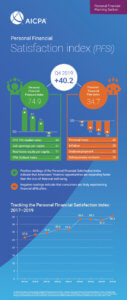Americans start 2020s with financial satisfaction at a record high
Americans’ financial well-being roared into the 2020s. For the seventh time in the last two and a half years, the average American’s financial satisfaction hit an all-time high, according to the AICPA’s quarterly Personal Financial Satisfaction index (PFSi). With all these positive records, you may wonder what it means for you.
First, a little background: The PFSi is a quarterly economic indicator that measures the financial standing of the average American. It’s calculated as the difference between two sub-indexes: The Personal Financial Pleasure Index, which measures the growth of assets and opportunities, and the Personal Financial Pain Index, which calculates the loss of assets and opportunities. Most recently, the Pleasure Index (74.9) greatly outweighed the Pain Index (34.7), bringing the Q4 2019 PFSi to a positive reading of 40.2, the highest reading in the index’s 26-year history.
Richard Ward, CPA/PFS, a member of the AICPA’s National CPA Financial Literacy Commission, spoke to AICPA Insights about the index results and what the record-setting quarter means for Americans.
Are the results of the Q4 2019 PFSi consistent with what you are seeing? What are you recommending to your clients?
RW: The PFSi just reached an all-time high, indicating that the average American should be feeling a strong sense of financial well-being. Many of my clients feel quite positive about the growth of their assets over the past decade. We are taking these prosperous times as an opportunity to review all outstanding liabilities and decide whether any debt payments should be accelerated or paid off in full. This is also an excellent time to ensure that there is ample cash on hand for when times are not as good. It’s essential for individuals of all ages to maintain focus on their long-term goals and stay the course.
While times are this good, where should Americans place their focus?
RW: It is encouraging to see such sizable returns throughout the run of this current bull market. Thanks to the stock market’s positive performance, the PFS 750 Market index reached a record high. It accounts for one-third of the Personal Financial Pleasure index, and it has helped boost the Pleasure index to an all-time high itself. However, if you don’t own stocks, you’re not seeing any of this benefit. Most people understand the idea of working to make money. Investing is the concept that you can grow money by making it work for you. Before jumping into the market, take time to learn the investing basics.
In prosperous times like this, it is important to be cautiously optimistic. Remember, a robust market and economy is cyclical. Be appreciative of financially favorable times but cognizant that they won’t continue forever. Keep in mind that certain investments may be suitable for young investors, but they probably won’t be appropriate for those nearing retirement or already drawing down their portfolio for living expenses. With that in mind, make sure that your portfolio and financial plan align with the time horizons of your personal financial goals. By positioning your financial plan accordingly, you will help to safeguard your finances from a potential pullback.
In this current labor environment, what should Americans of all ages keep in mind?
RW: After trending down for the last decade, underemployment is at a new all-time low. Job openings are hovering just shy of their recent record high. A great job market like the one is the perfect time for Americans to shore up their emergency fund, double-check they’re making the most of their work benefits, and even consider shopping around to see if there is a better opportunity in their field.
It is great news that the average Americans’ financial satisfaction is at an all-time high. But for those who are not feeling the benefits of this record, where would you suggest they begin to improve their financial situation?
RW: The current environment is a perfect time to analyze your financial situation. You can do this by taking a personal inventory of all income and expenses, based on actual past spending (past three months should be sufficient). Then, calculate how much money you’re bringing in after taxes and how much you have left after covering your monthly bills. This process will help you become more aware of where your dollars are going and help to reduce frivolous spending. After every two weeks, review your budget to make sure you are not spending more than you make. If you have extra cash, consider increasing your savings rate, retirement contributions or build up that emergency fund. Just like a financial plan, making a budget is not a “one-and-done” process; it requires frequent monitoring and updating as financial situations change (e.g., raise, bonus, laid off, hours cut, etc.).

Posted by AICPA Communications on Jan 23, 2020
Check out the free resources available on the AICPA’s 360 degrees of financial literacy website. Once there, you can find budgeting tips, savings calculators, articles full of insight on a wide range of financial topics and a tool to help you build your financial plan.
Jon Lynch, Manager – Public Relations, Association of International Certified Professional Accountants
Click here to read the full article
